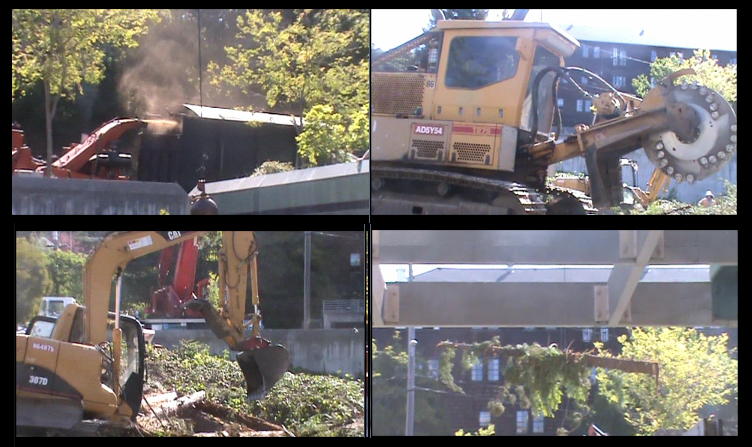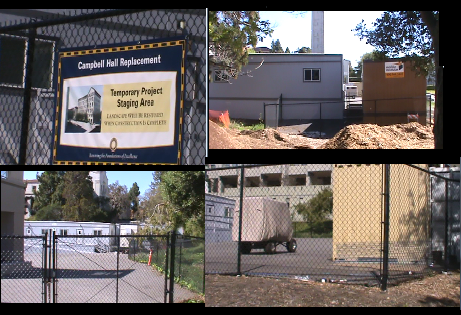From the Open-Publishing Calendar
From the Open-Publishing Newswire
Indybay Feature
Redwood Grove Destroyed Day After Earth-Day For Qualcomm Executive-Director
On April 23, the the day after Earth-Day, the 'More Redwoods, Less Surveillance' grove behind Soda Hall in Berkeley was destroyed by the Professional Tree Care Company, as requested by the UC regents and the Qualcomm executive director, Paul Jacobs. The Caterpillar equipment arrived at 7AM, on what was the Wednesday before Arbor Day. The Paul Jacobs Design Institute (Jacobs Hall) could have been built on an available and larger lot adjacent to the engineering library, would have not necessitated the cutting down of the grove. Members of the public were lead to believe the UC would leave some trees on the north-west corner of the lot, yet all the trees were removed.

The Paul Jacobs Design Institute is part of an ongoing partnership between the UC and Qualcomm. UC regent Sherry Lansing joined the board of Qualcomm in 2006, receiving a director’s fee of $135,000 and over $1million in Qualcomm stock. (http://www.spot.us 'UC Investor's Club'). In return, the UC then quadrupled it's investment in Qualcomm to $397,000,000. The corporation also has a branding presence on UC Berkeley campus at the 'Qualcomm Cafe'. Now the executive director (former CEO and son of the founder) of Qualcomm, Paul Jacobs is establishing a privately funded technology design institute on campus. The UC's patent policy states that "an agreement to assign inventions and patents to the University, except those resulting from permissible consulting activities without use of University facilities, shall be mandatory"; this obligation is extended to employees (faculty included) and non employees (students included). There will be many lucrative patents developed at the new tech design facility, which the UC could give Qualcomm exclusive rights to. The grant of the building is an investment which offers a strong, long term return. Qualcomm is a member of US business coalition in support of the TransPacific Partnership, which would strengthen patent control and usage rights for the large multinationals, increasing the global corporate power over intellectual property and patent innovation.
April 23rd was both the day the redwood grove was cut and also the day the news story broke that Qualcomm was being investigated by the SEC (Securities Exchange Commision) and the DOJ (Department of Justice). The corporation is suspected of violating the Foreign Corrupt Practices Act (FCPA), by bribing Chinese officials to strengthen its market position. Qualcomm is also facing allegations of price fixing, taking advantage of its growing position in China. Qualcomm's growth in the US has slowed, and the corporation is trying to expand its Chinese sales. Qualcomm's overseas sales had dropped, as the corporation was plagued by speculation that the NSA had backdoor access to their chip-sets.
::::::::::::::::::
Members of the public were lead to believe that some of the trees, in the north-west corner of the Paul Jacobs development, would be left to stay. This claim by the UC had been repeated multiple times, reinforced by a statement by the marketing director of UC Berkeley's engineering department (Karen Rhodes) that some redwoods would be at the corner in response to public input. Public input has been completely ignored on this project, including an alternate proposal for the building's placement. None of the trees actually had to be removed for the development, as there is an available lot near the engineering library which is larger than the lot behind Soda Hall, and in a more central location making the building accessible to students of different fields of study. The UC never gave any explanation as to why the building could not be placed by the engineering library, preserving the redwoods.
Police intimidation was used to keep people away from the protest, including the regular use of a police dog. On the evening of Earth Day, the police parked a detention van (paddy wagon) at the grove, due to an announced Earth Day info-session 'The Ecological Costs of the Surveillance State'. The police presence at the grove increased when the protest introduced issues pertaining to Qualcomm's ties to the Department of Homeland Security and the Defense Department. Qualcomm's big break into government contracts came from a 1994 contract for Code Division Multiple Access (CDMA) digital cellular system architecture. Over the years, Qualcomm directly lobbied for military contracts and has lobbied for DHS contracts. As for questions of ties to NSA spying programs, the protest raised concerns that it has not been clarified that Qualcomm did not assist the NSA.
Qualcomm's more recent phone chipsets are noted as being "always on" and "always listening", and have advanced GPS tracking. Their Moto X co-project has been called the perfect spy phone, the perfect phone for data collection. Security experts have raised concerns about the Moto X, as hackers or government agencies don't have to force on the microphone; it's already on. Privacy advocates are concerned about the amount of data the phone collects. With privacy and surveillance in the forefront of political and social discourse, there are concerns about the intrusion of Big Surveillance into consumer electronics.
The "More Redwoods, Less Surveillance" protest was an investigation into the ties between the UC, tech corporate partners and government agencies. The protest explored the UC's patent policy, and a need for patent reform. The protest was also marking this 50th anniversary year of the Free Speech movement, which began in Berkeley in 1964.
April 23rd was both the day the redwood grove was cut and also the day the news story broke that Qualcomm was being investigated by the SEC (Securities Exchange Commision) and the DOJ (Department of Justice). The corporation is suspected of violating the Foreign Corrupt Practices Act (FCPA), by bribing Chinese officials to strengthen its market position. Qualcomm is also facing allegations of price fixing, taking advantage of its growing position in China. Qualcomm's growth in the US has slowed, and the corporation is trying to expand its Chinese sales. Qualcomm's overseas sales had dropped, as the corporation was plagued by speculation that the NSA had backdoor access to their chip-sets.
::::::::::::::::::
Members of the public were lead to believe that some of the trees, in the north-west corner of the Paul Jacobs development, would be left to stay. This claim by the UC had been repeated multiple times, reinforced by a statement by the marketing director of UC Berkeley's engineering department (Karen Rhodes) that some redwoods would be at the corner in response to public input. Public input has been completely ignored on this project, including an alternate proposal for the building's placement. None of the trees actually had to be removed for the development, as there is an available lot near the engineering library which is larger than the lot behind Soda Hall, and in a more central location making the building accessible to students of different fields of study. The UC never gave any explanation as to why the building could not be placed by the engineering library, preserving the redwoods.
Police intimidation was used to keep people away from the protest, including the regular use of a police dog. On the evening of Earth Day, the police parked a detention van (paddy wagon) at the grove, due to an announced Earth Day info-session 'The Ecological Costs of the Surveillance State'. The police presence at the grove increased when the protest introduced issues pertaining to Qualcomm's ties to the Department of Homeland Security and the Defense Department. Qualcomm's big break into government contracts came from a 1994 contract for Code Division Multiple Access (CDMA) digital cellular system architecture. Over the years, Qualcomm directly lobbied for military contracts and has lobbied for DHS contracts. As for questions of ties to NSA spying programs, the protest raised concerns that it has not been clarified that Qualcomm did not assist the NSA.
Qualcomm's more recent phone chipsets are noted as being "always on" and "always listening", and have advanced GPS tracking. Their Moto X co-project has been called the perfect spy phone, the perfect phone for data collection. Security experts have raised concerns about the Moto X, as hackers or government agencies don't have to force on the microphone; it's already on. Privacy advocates are concerned about the amount of data the phone collects. With privacy and surveillance in the forefront of political and social discourse, there are concerns about the intrusion of Big Surveillance into consumer electronics.
The "More Redwoods, Less Surveillance" protest was an investigation into the ties between the UC, tech corporate partners and government agencies. The protest explored the UC's patent policy, and a need for patent reform. The protest was also marking this 50th anniversary year of the Free Speech movement, which began in Berkeley in 1964.

Add Your Comments
Latest Comments
Listed below are the latest comments about this post.
These comments are submitted anonymously by website visitors.
TITLE
AUTHOR
DATE
Carbon dioxide.
Sat, Apr 26, 2014 8:39AM
We are 100% volunteer and depend on your participation to sustain our efforts!
Get Involved
If you'd like to help with maintaining or developing the website, contact us.
Publish
Publish your stories and upcoming events on Indybay.
Topics
More
Search Indybay's Archives
Advanced Search
►
▼
IMC Network


